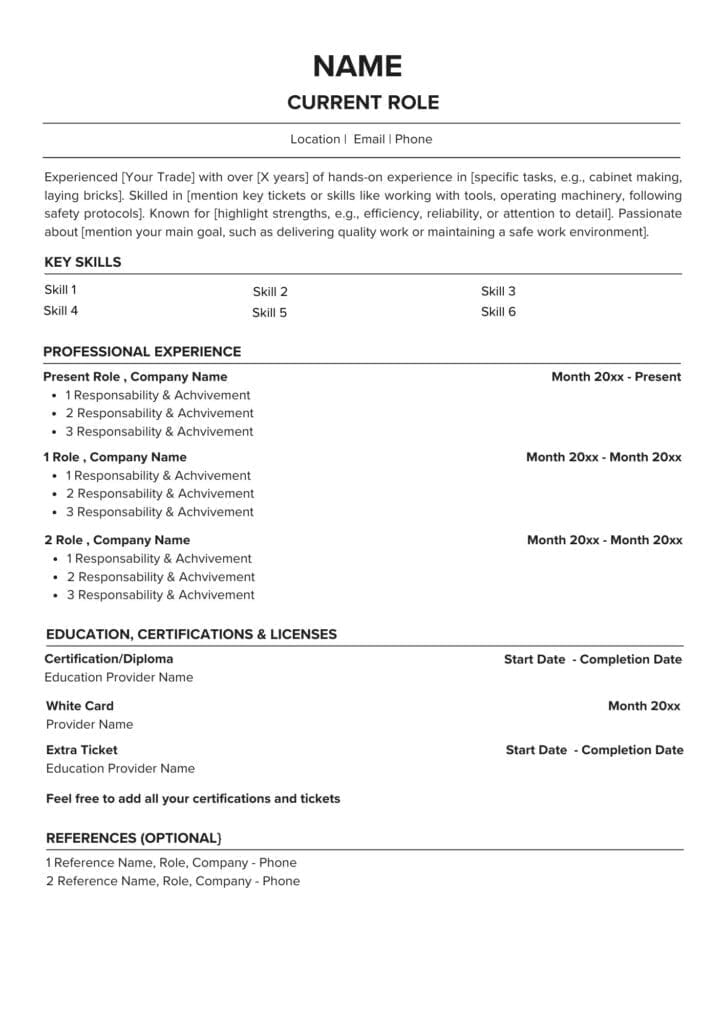Building an Effective Construction Career
In the construction industry, your resume is your ticket to securing top job opportunities. Many skilled tradespeople have the experience, the tickets, and the skills, yet still struggle to land a job. This often happens due to common resume mistakes such as lack of clarity, missing key certifications, or failing to highlight relevant experience effectively. Employers look for skills, experience, and certifications at a glance, so ensuring your resume stands out is crucial.
Here’s a step-by-step guide to building an effective resume for a construction career.
Layout Matters
Recruiters and hiring managers in construction often receive multiple applications for each job posting. Keep your resume to one or two pages, highlighting only the most relevant information. Use bullet points, clear headings, and easy-to-read fonts to make your resume easy to scan.
A well-structured resume increases your chances of getting noticed.
Follow this format:
Contact Information: Your full name, current role, phone number, email, and location.
Professional Summary: A brief but impactful introduction highlighting your skills and experience.
Skills Section: List your key technical and soft skills.
Work Experience: Present your past jobs in reverse chronological order (most recent to oldest), emphasising responsibilities and achievements.
Certifications & Tickets:
Mention relevant courses, apprenticeships, or degrees. Also showcase your industry-required qualifications and extra tickets
References: Optional, unless requested by the employer.


1. Start With a Strong Summary
Begin your resume with a powerful summary that showcases your expertise and experience. This section should be a 3-4 sentence snapshot of who you are, your skills, and what you bring to the table.
Example:
Experienced [Your Trade] with over [X years] of hands-on experience in [specific tasks, e.g., cabinet making, laying bricks]. Skilled in [mention key tickets or skills like working with tools, operating machinery, following safety protocols]. Known for [highlight strengths, e.g., efficiency, reliability, or attention to detail]. Passionate about [mention your main goal, such as delivering quality work or maintaining a safe work environment].
2. Highlight Your Skills
The construction industry values both technical and soft skills. List your most relevant skills in a separate section so they stand out to recruiters.
Example:
Technical Skills
✔ Equipment operation (forklifts, excavators, etc.)
✔ Concrete pouring and finishing
✔ Welding and fabrication
✔ Electrical and plumbing knowledge
✔ Framing and drywall installation
✔ Occupational health and safety (OH&S) compliance
Soft Skills
✔ Teamwork and communication
✔ Problem-solving
✔ Time management
✔ Attention to detail
3. Showcase Your Work Experience
Your experience section should highlight relevant roles and achievements. List your jobs in reverse chronological order (most recent first), including the company name, job title, and employment dates.
Best Practices for Describing Your Roles:
- Be Specific: Mention the type of work you performed (e.g., commercial, residential, civil).
- Use Action Verbs: Words like constructed, installed, repaired, operated add impact.
- Highlight Achievements: If you contributed to completing projects ahead of schedule or maintained a high standard of safety, mention it.
- Include Project Scope: If applicable, state the size or complexity of projects worked on.
Example:
Construction Labourer | XYZ Builders | 2020 – Present
Assisted with framing, concrete pouring, and roofing for residential projects.
Worked on high-profile projects, ensuring compliance with all site regulations.
Followed strict safety procedures to maintain a hazard-free worksite.
Operated power tools and heavy machinery safely and efficiently.
4. Education, Certifications and Licenses
Construction employers often require specific certifications and training, so listing them prominently is essential. Combine education, certifications, and licenses in one section for clarity. Include the name of the certification/license, issuing provider, and year obtained (if recent).
Example:
Certificate III in Carpentry – TAFE Queensland, 2018
Apprenticeship – ABC Construction, 2016-2018
White Card (Construction Induction Training) – Safe Work Australia
Working at Heights Certification – High-Risk Training Institute
High-Risk Work License (e.g., forklift, crane operation) – Workplace Safety Authority
First Aid and CPR – Red Cross
Traffic Control and Management – Traffic Training Solutions
5. References (If Requested)
Most employers will ask for references, so be prepared with a list of past supervisors or colleagues who can vouch for your skills and work ethic. If not requested upfront, simply state: “References available upon request”. Having references ready can strengthen your application and help employers verify your experience quickly. At Your Trades and Your Resourcing, we always ask for references to confirm your experience and skills.
Ready to Move Your Resume Forward?
If you’re in the construction industry and looking for a new job, check out our available roles and apply today! At Your Trades and Your Resourcing, we specialise in connecting skilled workers with top opportunities in the construction sector.
